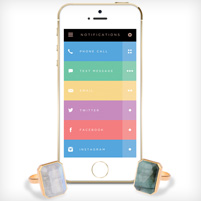Smart Jewelry

Christina Mercando (CMU'04)

Ringly app & rings
A cocktail ring has stepped in to replace clunky phones and intrusive ringtones.
Ringly, a N.Y.-based company, offers a ring that vibrates and emits a small colored light when its wearer receives a call, text, email or other alert.
Founder and CEO Christina Mercando (CMU'04) graduated with a BFA/BHCI degree from Carnegie Mellon University.
Mercando thought of the idea when she found herself missing calls because her phone was in her purse.
"I was very frustrated that everyone had their screens out and on the table. I wanted to go back to those times where you're enjoying company. At the same time, we live in a very connected world, so you want to stay connected," Mercando said.
She said she realized that her jewelry wasn't "doing" anything. She started considering what could happen if she inserted a tiny circuit board into a ring. Interactive objects such as this are part of the new world of physical computing, where interactive physical systems can sense and respond to the real world. Physical computing activities are growing at Carnegie Mellon. The Integrative Design, Arts & Technology Network (IDeATe) recently launched a Physical Computing concentration/minor and related courses in that area this fall.
Mercando found it easy to conceptualize art and technology. As an undergraduate she pursued dual majors in fine arts and human-computer interaction. As she started brainstorming more about how to make the ring, she brought it to an event she organized called "Side-Project Saturdays." It was at one of these meetings that she met Logan Munro who was interested in engineering her idea. Together they looked for a jewelry designer.
"It was something I learned at CMU, the importance of collaboration. It's fun to watch my co-founder, who is a logical thinker, learn about the jewelry. And it's fun to see my designer learn about the engineering," Mercando said. "The greatest resource CMU provided was access to great people who have entrepreneurial spirit. So many of my friends from CMU went on to become entrepreneurs and I've been able to learn so much from them."
The side project grew quickly, and both decided to pursue it full time. They now have eight employees, and are hiring. At the time Mercando was working at eBay, and wearable technology — like today's Google Glass and Apple watches — hadn't been dreamed up.
"When I told eBay I was leaving to make vibrating rings, they thought I was crazy," she said.
The crazy idea found its audience quickly — Ringly was rolled out and in under 24 hours reached more than $100,000 in sales. Later the company sold out for all the orders it can fill this year. (Current orders will be shipped in early 2015.)
Karen Kornblum Berntsen, an associate teaching professor with CMU's Human-Computer Interaction Institute, which recently celebrated its 20th anniversary, teaches studio courses that focus on the intersection of design, psychology and computing. She said Ringly is a perfect example of the kind of "design thinking" that takes place in her classes.
"It's up to us as designers to shape technology in a humane way. It's the ideal goal of the HCI, and I think Christina illustrates this. The ring is modest and meets a very specific need. It is a simple, understated, tasteful product," Berntsen said.
Related Links: School of Computer Science | Human-Computer Interaction Institute | IDeATe | College of Fine Arts | Ringly
